|
  
Institute for Geo-Resources and Environment
National Institute of Advanced Industrial Science and Technology
Central 7, 1-1-1 Higashi, Tsukuba, 305-8567, JAPAN.
Tel.: +81-298-61-2000
Copyrignt (C)
Geomicrobiology Research Group.
All rights reserved. |
|
Purpose
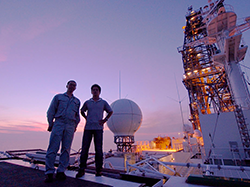
Through terrestrial and marine deep subsurface drillings to investigate the Earthfs interior, we have been learning the widespread occurrence of microbes of great diversity in deep subsurface. The activities of these microbes play important roles in the material cycles in Earth systems, and greatly contribute to the formation of natural gas fields and methane hydrate. They also contribute to the preservation of geoenvironment through degradation of toxic substances in soil and groundwater.
Advanced knowledge about the activities of subsurface microbes is required for efficient exploration and exploitation of underground resources. It is also important for the development of technologies to mitigate groundwater and soil pollutions (geopollution). By applying geochemical methods such as isotope and lipid analyses together with microbiological methods such as tracer experiment, cultivation experiment, and gene analysis, and by collaborating with researchers within and outside AIST, we investigate the distribution, functions, and activities of subsurface microbes, aiming to contribute to the development of resources such as natural gas and to the utilization and preservation of geo-environments.
Ongoing major research projects
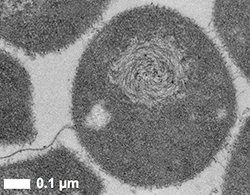 ‘ Formation mechanism of methane hydrate and water-soluble gas deposits ‘ Formation mechanism of methane hydrate and water-soluble gas deposits

Methane hydrate is widely distributed in marine sediments along continental margins and
recently paid much attention to as new energy resources. Methane forming
hydrate is interpreted to be mostly produced by subseafloor microbes. However,
it is not clear when and where the methane was produced. Methane in water-soluble
gas fields in Japan indicates microbial origin. The methane has the same enigma as
methane forming hydrate has. Our project is to aim to elucidate a formation
mechanism of methane hydrate and water-soluble gas deposits. We research
distribution and diversity of microbes around the natural gas-bearing regions
and estimate their activities. |
|

page top £ |
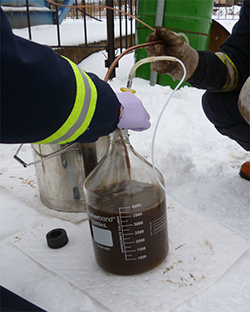 ‘ Oil degradation and methanogenic pathways by microbes in oil reservoir ‘ Oil degradation and methanogenic pathways by microbes in oil reservoir

More than 50% of crude oil remains unrecovered in the subsurface of depleted oil fields after full application of currently available technologies. Development
of an innovative technology for enhanced oil recovery could increase available
energy resources. In recent years, expectation is getting higher for the
technology of microbial oil-to-methane conversion in the subsurface, which
enables further recovery the oil as natural gas. To seek for this possibility,
we conduct incubation experiments simulating the conditions of an oil reservoir
in cooperation with INPEX Corporation and Tokyo Gas Corporation, aiming to elucidate the oil degradation
and methanogenic pathways to identify microbes mediating the processes. |
|

page top £ |
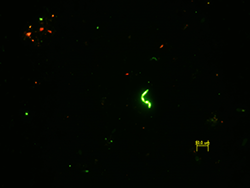 ‘ Anaerobic methane oxidation in the terrestrial subsurface environments ‘ Anaerobic methane oxidation in the terrestrial subsurface environments

Methane is 21 times more powerful a greenhouse gas than CO2. It is important
to understand biogeochemical cycle of methane. Microbes are responsible
for not only methane production, but also methane consumption. Methane
consuming microbes thus play an important role in controlling the emission
of methane to the atmosphere from the geo-environments. However, we still
do not fully understand this microbial process, especially anaerobic oxidation of methane (AOM). In a recent decade, anaerobic methane oxidizing archaea have been
found to oxidize up to 80% of the methane produced in the marine sediments
before its release into the hydrosphere. In contrast, many questions remain
concerning AOM in the terrestrial environments; Who does it? Where is it?
And how much is it? Our project aims to find the answers for these questions
targeting shallow subsurface sediments in the Kanto Plain, Japan. |
|

page top £ |
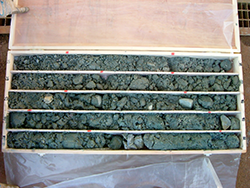 ‘ Bioremediation of subsurface contaminants ‘ Bioremediation of subsurface contaminants

Most of the available freshwater resources exist in the subsurface environments
as groundwater. Subsurface contamination caused by human activities leads
to a contamination of groundwater (geopollution), and this threatens human health. Bioremediation is one of the promising
technology to mitigate the contamination. Contamination by the volatile
chlorinated organic compound such as trichloroethylene and tetrachloroethylene
can be treated by subsurface microbes such as methane oxidizing bacteria
and anaerobic dechlorinating bacteria. We are collaborating with private
companies to (1) develop low cost bioremediation technology utilizing groundwater
in the natural gas field area which is rich in methane, and (2) develop
bioremediation technology for the contaminated aquitards. |
|

page top £ |
|






